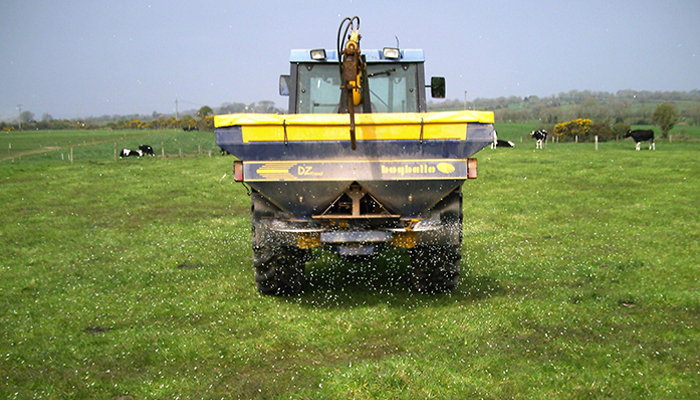27 January 2025
Fertiliser spreading dates

Although applications of chemical fertiliser are now permitted in Zone A, with Zones B and C opening in the coming days and weeks, this does not necessarily mean now is the time to spread.
To maximise nutrient use efficiency and to prevent losses to water, farmers are reminded to only apply the right fertilisers, in the right place on the farm, at the right rate and at the correct times of the year. A Nutrient Management Plan, built on the basis of up-to-date soil samples, and input from your advisor will be critical to selecting the right product and the right rate. The timing of application, however, is dependent on a number of variables, most important being the ground and weather conditions present on your farm.
During risky periods of the year, farmers are reminded to carefully select the fields that receive nutrients through chemical fertilisers. Remember, fields with high connectivity to waters have increased potential for losses of nutrients.
Key points:
- Checking the weather forecast in advance of spreading fertiliser is critical to minimise runoff and leaching of nutrients.
- Never spread chemical fertilisers, livestock manures, soiled water or other organic fertilisers when:
- The land is waterlogged.
- The land is flooded, or it is likely to flood.
- The land is frozen or covered with snow.
- Heavy rain, i.e., a Met Eireann ‘yellow’, ‘orange’ or ‘red’ rainfall warning, is forecast within 48 hours.
- To maximise nutrient uptake, chemical fertiliser should be applied when the crop is growing (soil temp > 6o C) and no heavy rainfall forecast for at least 48 hours. On poorer draining soils, this period should be longer.
- Do not spread chemical fertilisers on land within 3 meters of any surface waters and where relevant adhere with buffer zones outlined in table 1 below.
- Chemical fertilisers should not be spread on ground with a steep slope (>10%) and if there is a significant risk of causing pollution.
- Where early fertiliser applications are required, they should be applied to productive fields in good fertility to maximise nutrient use and to prevent losses.
Table 1: Buffer zones for spreading organic fertilisers near different kinds of waterbodies (lakes, rivers, wells, etc.). Soiled water, effluents, FYM or other organic fertilisers cannot be spread inside the following buffers.
| Water body / feature | Buffer zone |
|---|---|
| Any water supply source providing 100m3 or more of water per day, or serving 500 or more people |
200 metres (or as little as 30 metres where a Local Authority allows) |
| Any water supply source providing 10m3 or more of water per day, or serving 50 or more people |
100 metres (or as little as 30 metres where a Local Authority allows) |
| Any other water supply for human consumption, including boreholes, springs or wells used for water abstraction |
25 metres (or as little as 15 metres where a Local Authority allows) |
| Lake shoreline or turloughs likely to flood | 20 metres |
| Exposed cavernous or karstified limestone features (e.g., swallow holes and collapse features) |
15 metres |
| Any surface watercourse where the slope towards the watercourse exceeds 10% |
10 metres |
| Any other surface waters | 5 metres |
Dates
- The prohibited period for chemical fertiliser applications (Nitrogen or Phosphorus applications) for farmers in Zone A, encompassing the counties of Carlow, Cork, Dublin, Kildare, Kilkenny, Laois, Offaly, Tipperary, Waterford, Wexford and Wicklow, ended on January 26th, 2025.
- The earliest date in which farmers in Zone B, which consists of counties Clare, Galway, Kerry, Limerick, Longford, Louth, Mayo, Meath, Roscommon, Sligo and Westmeath, can spread chemical fertilisers is January 30th, as the prohibited period for applications ends on January 29th.
- The earliest date farmers in Zone C counties – Cavan, Donegal, Leitrim and Monaghan – can spread chemical fertilisers containing N or P is February 15th, as the prohibited period for applications ends of February 14th in this Zone.
Protecting water quality when spreading slurry
In the below video, David Melody, a dairy farmer from Co. Kilkenny, and Deirdre Glynn, a Teagasc ASSAP Advisor, remind farmers of the key considerations to bear in mind before committing to spreading slurry.
Also read: Fertiliser planning: How did protected urea perform in 2024?
Also read: Don’t lose faith in protected urea
Also read: Slurry is a valuable nutrient – use it correctly
